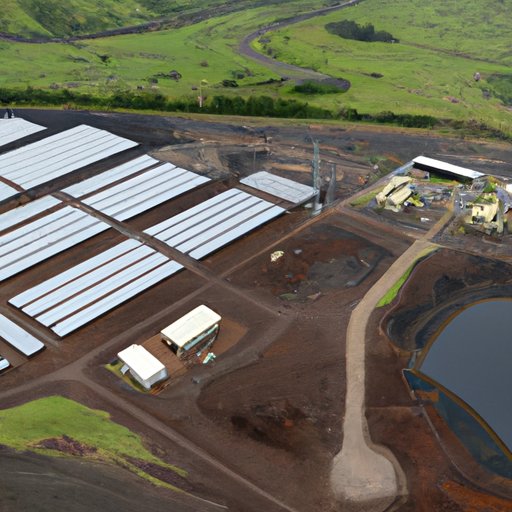Introduction
Have you ever wondered how Hawaii powers its homes and businesses? While you may not give much thought to where your electricity comes from, it’s important to understand the sources and infrastructure behind it. Hawaii is unique in the way it generates power, with a focus on renewable energy sources. In this article, we will explore Hawaii’s shift towards renewable energy, the history of electricity infrastructure, the role of the utility company, community efforts, and challenges the state faces in meeting its electricity needs.
The Use of Renewable Energy Sources
Hawaii has made a significant effort towards renewable energy sources in recent years. This shift is driven by several factors, including the high cost of importing oil to the islands, environmental concerns, and the state’s abundance of renewable energy resources such as solar, wind, and geothermal power.
Solar power is one of the most popular renewable energy sources in Hawaii. The state’s location near the equator allows for ample sunlight, which can be harnessed through photovoltaic (PV) panels on homes and businesses. Large-scale solar farms also provide electricity to the grid system. Wind power is also prevalent in Hawaii, especially on the island of Maui. Wind turbines generate power that is sent to the grid and used to power homes and businesses. Geothermal power is a lesser-known renewable energy source in Hawaii. It involves using heat energy from the earth’s core to generate electricity. The Big Island of Hawaii has several geothermal power plants that provide electricity to the grid system.
Each technology has its benefits and drawbacks, but they all contribute to Hawaii’s push towards renewable energy. Solar power is clean and easy to install, but it can be expensive. Wind power is cost-effective and reliable, but it requires a significant amount of land. Geothermal power is reliable and consistent, but it can cause environmental concerns.
Despite these challenges, Hawaii has made impressive progress in its shift towards renewable energy. As of 2021, the state was producing more than 30% of its electricity from renewable sources.
The History of Electricity in Hawaii
The use of electricity in Hawaii has undergone significant changes since its inception. The first power plants in Hawaii were built in the early 1900s, and they primarily used coal. Over time, the state began to shift towards oil as its primary source of energy. However, the rising cost of importing oil led to Hawaii’s push towards renewable energy.
The grid system and network of power lines developed over time as the demand for electricity increased. Hawaii’s island geography presents unique challenges, as the islands are separated by large bodies of water. To overcome this, undersea cables were installed to connect the islands and allow for the sharing of electricity. Today, the state’s power grid is a complex network of transmission and distribution lines that allows for the efficient distribution of electricity across Hawaii.
The Role of the Utility Company
The utility company that provides electricity to Hawaii residents is the Hawaiian Electric Company (HECO). The company has a unique set of challenges and opportunities due to Hawaii’s focus on renewable energy sources. HECO is responsible for maintaining the electricity infrastructure, managing the power grid, and ensuring that there is a reliable supply of electricity across the state.
One of HECO’s primary challenges is the integration of renewable energy into its power grid. While renewable energy sources are clean and cost-effective, they can be intermittent and difficult to control. This can make it challenging to maintain a stable supply of electricity to customers. HECO is working to address these challenges through the use of smart grid technology and energy storage systems.
Community Efforts and Innovations
Hawaii’s culture of sustainability and environmentally friendly practices is reflected in the efforts of individuals and groups on the islands. Many residents have taken steps to reduce their power consumption and promote conservation. This includes strategies such as energy-efficient appliances, using public transportation, and utilizing LED lighting.
Community efforts and innovations have also played a significant role in reducing electricity usage in Hawaii. For example, some organizations have implemented rooftop solar programs that allow residents to install solar panels on their homes at an affordable cost. Other groups have implemented energy efficiency programs that provide education and resources to help residents reduce their power consumption.
Challenges with Meeting Electricity Needs
Hawaii faces several challenges in meeting its electricity needs. One of the most significant challenges is the growing population and increasing demand for energy. As more people move to Hawaii, the demand for electricity will continue to increase, putting pressure on the state’s infrastructure.
Another challenge is the intermittency of renewable energy sources. As mentioned earlier, renewable energy can be unreliable and difficult to control. This can make it challenging to maintain a consistent supply of electricity to customers. HECO is working to address this challenge through the use of energy storage systems, which allow excess energy to be stored in batteries for later use.
Conclusion
In conclusion, Hawaii’s shift towards renewable energy sources is an impressive feat that has been driven by a unique set of challenges and opportunities. The state’s focus on solar, wind, and geothermal power has allowed it to reduce its reliance on imported oil and take significant steps towards a more sustainable future. The history of electricity infrastructure in Hawaii has evolved over time, and the grid system is a complex network that serves the diverse needs of the islands. The role of HECO is critical in ensuring a reliable supply of electricity to customers, and community efforts and innovations have played a significant role in reducing electricity usage. Hawaii faces several challenges in meeting its electricity needs, but continued efforts towards renewable energy and energy efficiency provide hope for a more sustainable future.
(Note: Is this article not meeting your expectations? Do you have knowledge or insights to share? Unlock new opportunities and expand your reach by joining our authors team. Click Registration to join us and share your expertise with our readers.)
